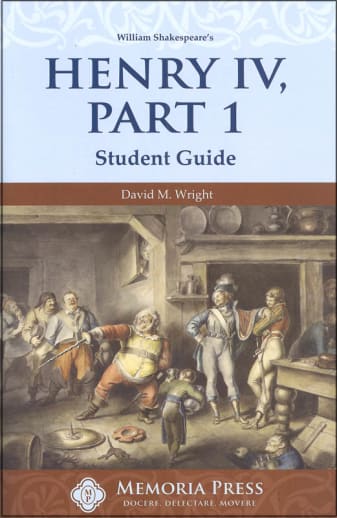The Henry IV, Part 1 Student Guide contains vocabulary studies, reading notes, comprehension questions, Socratic discussion questions, work with quotes, and literary and rhetorical devices. The Henry IV, Part 1 Student Guide is designed to guide students through the grammar, logic, and rhetoric stages towards the central proposition that gives the story ultimate meaning and expression. Upper-School Student books are now in a smaller, non-consumable format. The format of these guides helps older students transition away from a workbook mentality and prepares them for college classes by teaching them to take their own notes and glean information from lectures, class discussions, and the text. The answers are contained in the Henry IV, Part 1 Teacher Guide.
Henry IV, Part 1 Student Guide
SKU
008037
ISBN
9781547702268
Grade 9-AD
Classical
Neutral
Medium Teacher Involvement
Visual
Other Materials Required
These icons are designed to help you quickly understand and learn important information about our products.
Teaching Method
Traditional
Teacher-centered curriculum commonly used in classrooms that may include a text, teacher manual, tests, etc.
Charlotte Mason
A methodology based on the work of a 19th century educator who maintained that children learn best from literature (Living Books), not textbooks.
Classical
A methodology based on the Latin Trivium (three stages of learning), including the grammar stage (memorization and facts), logic stage (critical thinking), and rhetoric stage (developing/defending ideas).
Unit Study
A thematic or topical approach centered around one topic that integrates multiple subject areas.
Montessori (Discovery)
A methodology based on the work of a 20th century educator that emphasizes student and sensory-driven discovery learning and real-life applications.
Other
Other methodologies
Religious Content
Secular
Contains content contrary to common Christian beliefs (i.e. evolution).
Neutral
Avoids religious or theoretical topics or presents multiple viewpoints without preference.
Christian/Religious
Faith-based or including instructional religious content.
Learning Modality
Auditory
Learns through listening, talking out loud or reading out loud.
Visual
Learns through seeing, prefers written instructions and visual materials.
Kinesthetic/Tactile (Hands-On)
Learns through moving, doing and touching.
Multi-Sensory
Curriculum that employ a variety of activities/components.
Presentation
Sequential
Curriculum progresses through well-defined learning objectives. Emphasizes mastery before moving to the next topic.
Spiral
Topics and concepts are repeated from level to level, adding more depth at each pass and connecting with review.
Conceptual/Topical
Focus is on the “why,” often with a unifying concept as well as specific skills; coverage may be broader.
Teacher Involvement
Low Teacher Involvement
Student-led materials; parent acts as a facilitator.
Medium Teacher Involvement
A mix of teacher-led time and independent student work.
High Teacher Involvement
Teacher-led lessons; may utilize discussions, hands-on activities and working together.
Additional Materials Required
No other materials needed
Everything you need is included.
Other Materials Required
There are additional required resources that are a separate purchase.
Other Materials Optional
There are additional resources mentioned or recommended but are not absolutely necessary.
Consumable
Consumable
Designed to be written in; not reusable.
Non-Consumable
Not designed to be written in; reusable.
Our Price
$13.95 $13.95 $11.95
Rainbow Savings: $2.00
Description
Publisher's Description of Henry IV, Part 1 Student Guide
Category Description for Alternate Literature Options from Memoria Press
Offered as an alternative to the grade level selections, this collection of literature guides (and books) offers family choices to meet individual student or family needs. For each study, the Teacher Guide, Student Guide, and book are required.
Details
| Product Format: | Paperback |
|---|---|
| Grades: | 9-AD |
| Brand: | Memoria Press |
| ISBN: | 9781547702268 |
| Length in Inches: | 9 |
| Width in Inches: | 6 |
| Height in Inches: | 0.25 |
| Weight in Pounds: | 0.35 |
Videos
Reviews

